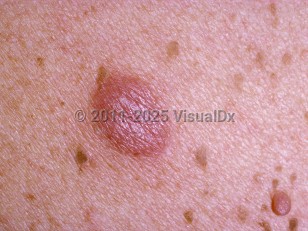Pseudolymphoma in Child
Alerts and Notices
Important News & Links
Synopsis

Triggers include insect bites or stings, which cause local reactions, or anticonvulsant drugs, which can cause widespread eruptions. Other causes include a broad range of non-anticonvulsant drugs (antihypertensives, lipid lowering agents, and antidepressants, among others), tattoo dyes, trauma, vaccinations, contact dermatitis, folliculitis, and infections (such as varicella, molluscum contagiosum, human immunodeficiency virus [HIV], or Lyme disease). Pseudolymphoma may be seen after scabies infection, particularly in children. Medication-related reactions may include fever, lymphadenopathy, and an erythematous skin eruption. Malaise, arthralgia, hepatosplenomegaly, eosinophilia, and abnormal liver function tests can also be present in medication-related cases.
While pseudolymphoma may occur at any age, it is most commonly seen in early adulthood.
Codes
L98.8 – Other specified disorders of the skin and subcutaneous tissue
SNOMEDCT:
19750001 – Pseudolymphoma
Look For
Subscription Required
Diagnostic Pearls
Subscription Required
Differential Diagnosis & Pitfalls

Subscription Required
Best Tests
Subscription Required
Management Pearls
Subscription Required
Therapy
Subscription Required
Drug Reaction Data
Subscription Required
References
Subscription Required
Last Updated:03/12/2018

